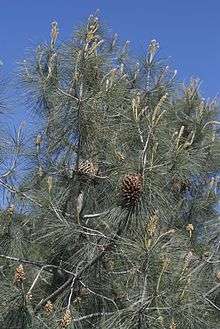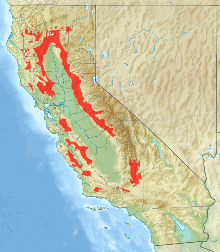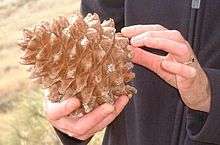Pinus sabiniana
| Pinus sabiniana | |
|---|---|
 | |
| Scientific classification | |
| Kingdom: | Plantae |
| Division: | Pinophyta |
| Class: | Pinopsida |
| Order: | Pinales |
| Family: | Pinaceae |
| Genus: | Pinus |
| Subgenus: | Pinus |
| Species: | P. sabiniana[2] |
| Binomial name | |
| Pinus sabiniana Douglas ex D.Don | |
Pinus sabiniana (sometimes spelled P. sabineana), with the common names ghost pine,[3][4] gray pine, California foothill pine, and the more historically and internationally used digger pine, is a pine endemic to California in the United States.[5][6][7][8] It is also known as foothill pine, bull pine, and nut pine.[3]
Description
The Pinus sabiniana tree typically grows to 36–45 feet (11–14 m), but can reach 105 feet (32 m) feet in height. The needles of the pine are in fascicles (bundles) of three, distinctively pale gray-green, sparse and drooping, and grow to 20–30 cm (8–12 inches) in length. The seed cones are large and heavy, 12–35 cm (4 3⁄4–13 3⁄4 inches) in length and almost as wide as they are long.[3][6][9] When fresh, they weigh from 0.3 to 0.7 kilograms (0.7 to 1.5 lb), rarely over 1 kilogram (2.2 lb).[10] The male cones grow at the base of shoots on the lower branches.[3][6][9]
Distribution and habitat

Pinus sabiniana grows at elevations between sea level and 1,200 metres (4,000 ft) and is common in the northern and interior portions of the California Floristic Province. It is found throughout the Sierra Nevada and Coast Ranges foothills that ring the Central, San Joaquin and interior valleys; the Transverse and Peninsular Ranges; and Mojave Desert sky islands.[6][9] It is adapted to long, hot, dry summers and is found in areas with an unusually wide range of precipitation: from an average of 250 mm (10 in) per year at the edge of the Mojave to 1,780 mm (70 in) in parts of the Sierra Nevada.[10] It prefers rocky, well drained soil, but also grows in serpentine soil and heavy, poorly drained clay soils. It commonly occurs in association with Quercus douglasii,[11] and "Oak/Foothill Pine vegetation" (also known as "Oak/Gray Pine vegetation") is used as a description of a type of habitat characteristic within the California chaparral and woodlands ecoregion in California, providing a sparse overstory above a canopy of the oak woodland.
Ecology
Pinus sabiniana needles are the only known food of the caterpillars of the Gelechiid moth Chionodes sabinianus. Fossil evidence suggests that it has only recently become adapted to the Mediterranean climate as its closest relatives are part of the Madrean pine-oak woodlands found at higher elevations in the southwest US and Mexico.[12] Some Indian groups relied heavily on pine nuts for food and are thought to have contributed to the current distribution pattern, including the large gap in distribution in Tulare County.
Taxonomy
Common name
The name digger pine supposedly came from the observation that the Paiute foraged for its seeds by digging around the base of the tree, although it is more likely that the term was first applied to the people; "Digger Indians" was in common use in California literature from the 1800s. The historically more common name digger pine is still in widespread use. The Jepson Manual advises avoiding this name as the authors believe "digger" is pejorative in origin.[13][14] It is also sometimes thought of as a pinyon pine, though it does not belong to that group.
| Language | Name |
|---|---|
| Achumawi | tujhalo |
| Chimariko | hatcho |
| Karuk | axyúsip |
| Klamath | gapga [15] |
| Konkow | tä-nē’ [16] |
| Maidu | towáni |
| Mono | tunah |
| Patwin | tuwa; sanank (pinenut) |
| Southern Sierra Miwok | sakky |
| Wappo | náyo |
| Wintu | xisi (unripe pinenut); chati (ripe pinenut) |
| Yana | c’ala’i [15] |
Botanical name

The scientific botanical name with the standard spelling sabiniana commemorates Joseph Sabine, secretary of the Horticultural Society of London. In botanical nomenclature it is no longer customary to Latinize species names (such as Sabine to sabinius and sabiniana) before forming Neo-Latin terms, so an orthographical correction was proposed from sabiniana to sabineana by some botanists. However the new spelling proposal has not been accepted by the United States Department of Agriculture (USDA) National Plant Data Center[5] or the University of California's "The Jepson Manual".[17] Nor has it been adopted into general use, with the spelling sabiniana used in the pine's endemic range by the University of California and state agencies,[3] and in its home country's U.S. federal agencies.[5] The USDA's Germplasm Resources Information Network (GRIN) database notes that the spelling sabiniana agrees with a provision in the Vienna Code of the International Code of Botanical Nomenclature, the governing body of botanical nomenclature. In that Code, Recommendation 60.2C states that personal names that are already in Latin or Greek, or those that have a well-established Latinized form can remain Latinized in species epithets, otherwise species epithets must be orthographically corrected to the proper form.[18] The GRIN database notes that Sabine's last name is not correctable and therefore Pinus sabiniana is the proper name for the species.[2]
See also
| Wikimedia Commons has media related to Pinus sabiniana. |
Notes
- ↑ Conifer Specialist Group, 1998
- 1 2 "Pinus sabiniana Douglas". Germplasm Resources Information Network (GRIN). Retrieved 1 October 2010.
- 1 2 3 4 5 "Calflora: Pinus sabiniana". Retrieved 2012-10-20.
- ↑ Moore, Gerry; Kershner, Bruce; Craig Tufts; Daniel Mathews; Gil Nelson; Spellenberg, Richard; Thieret, John W.; Terry Purinton; Block, Andrew (2008). National Wildlife Federation Field Guide to Trees of North America. New York: Sterling. p. 87. ISBN 1-4027-3875-7.
- 1 2 3 "Data Source and References for Pinus sabiniana (California foothill pine)". USDA PLANTS. Retrieved 2012-10-20.
- 1 2 3 4 UC/JEPS: Jepson Manual treatment for PINUS sabiniana. Retrieved 2012-10-20.
- ↑ James E. Cole. 1939
- ↑ Ludwig Beissner. 1909
- 1 2 3 "Classification for Kingdom Plantae Down to Species Pinus sabiniana Douglas ex Douglas". USDA PLANTS. Retrieved 2012-10-20.
- 1 2 Powers, Robert F. (1990). "Pinus sabiniana". In Burns, Russell M.; Honkala, Barbara H. Conifers. Silvics of North America. Washington, D.C.: United States Forest Service (USFS), United States Department of Agriculture (USDA). 1. Retrieved 2016-03-17 – via Northeastern Area State and Private Forestry (www.na.fs.fed.us).
- ↑ C. Michael Hogan, 2008
- ↑ Munz, P. "A California Flora and supplement" University of California Press
- ↑ Hickman, J.C. (Ed.) "The Jepson Manual, Higher Plants of California". University of California Press, Berkeley, 1993 p.120.
- ↑ Jepson Manual Online , "PINACEAE", accessed January 6, 2011.
- 1 2 Hinton, Leanne (1996). Flutes of fire :essays on California Indian languages. Berkeley, CA: Heyday Books. ISBN 978-0-930588-62-5.
- ↑ Chesnut, Victor King (1902). Plants used by the Indians of Mendocino County, California. Government Printing Office. p. 408. Retrieved 24 August 2012.
- ↑ UC/JEPS: Jepson Manual treatment for PINUS sabiniana
- ↑ International Code of Botanical Nomenclature. 2006. Recommendation 60C.2. Accessed online: 1 October 2010.
References
- Conifer Specialist Group (1998). "Pinus sabineana". IUCN Red List of Threatened Species. Version 2006. International Union for Conservation of Nature. Retrieved 12 May 2006.
- James E. Cole. 1939. The Cone-bearing Trees of Yosemite: Digger Pine
- A. Farjon (2005). Pines: Drawings and descriptions of the genus Pinus. Brill. ISBN 90-04-13916-8
- C. Michael Hogan (2008) Blue Oak: Quercus douglasii, GlobalTwitcher.com, ed. Nicklas Stromberg
- Discovery Channel (2010), MythBusters, Episode 138
- Ludwig Beissner. 1909. Handbuch der Nadelholzkunde: Systematik, Beschreibung, Verwendung und Kultur der Ginkgoaceen, Freiland- Coniferen und Gnetaceen. Für Gärtner, Forstleute und Botaniker, Published by P. Parey, 742 pages
Further reading
- Chase, J. Smeaton (1911). Cone-bearing Trees of the California Mountains. Chicago: A. C. McClurg & Co. p. 99. LCCN 11004975. OCLC 3477527. LCC QK495.C75 C4, with illustrations by Carl Eytel – Kurut, Gary F. (2009), "Carl Eytel: Southern California Desert Artist", California State Library Foundation, Bulletin No. 95, pp. 17-20 retrieved Nov. 13, 2011
External links
-
 Media related to Pinus sabiniana (category) at Wikimedia Commons
Media related to Pinus sabiniana (category) at Wikimedia Commons -
 Data related to Pinus sabiniana at Wikispecies
Data related to Pinus sabiniana at Wikispecies - Calflora Database: Pinus sabiniana (California foothill pine, Gray pine)
- Jepson Manual eFlora (TJM2) treatment of Pinus sabiniana
- USDA PLANTS Treatment for Pinus sabiniana (California foothill pine)
- Pinus sabiniana in the CalPhotos Photo Database, University of California, Berkeley
